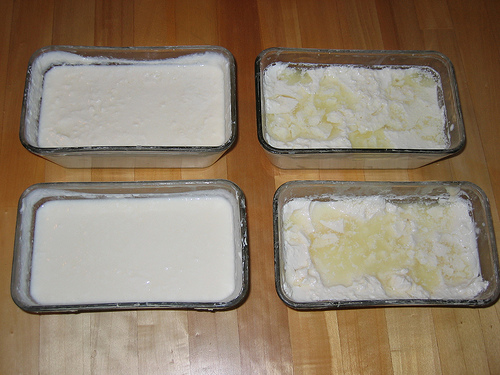 All yogurt recipes I’ve seen say you should preheat the milk before adding starter (= yogurt with live culture). Reasons vary. Some say it denatures the milk protein; others say it kills bacteria that might compete with the starter bacteria.
All yogurt recipes I’ve seen say you should preheat the milk before adding starter (= yogurt with live culture). Reasons vary. Some say it denatures the milk protein; others say it kills bacteria that might compete with the starter bacteria.
It was easy to measure the effect of preheating. I make yogurt using about a gallon of milk at a time, divided into four trays. I preheated two trays for 20 minutes and did not preheat the other two, leaving them at room temperature. After that I treated all four trays the same.
The photo above shows the results after incubation for 36 hours. The clumpy yogurt was preheated, the smooth yogurt was not. There was not a vast difference in taste. For most purposes clumpy is better so I will preheat in the future.
I was impressed that the experiment was fast, easy, safe, cheap, and conclusive, showing a large and lasting effect of a 20-minute treatment that had no visible effect. After the heated milk cooled, it looked the same as the unheated milk.
In case you need/want more ideas/recipes for fermented foods, this is a book I was given by a chef in the family. For a “cookbook” it has a fair amount of additional information about fermentation and live-culture foods.
https://www.amazon.com/Wild-Fermentation-Flavor-Nutrition-Live-Culture/dp/1931498237/ref=sr_11_1?ie=UTF8&qid=1235413740&sr=11-1
Why is clumpy yogurt better? Purely aesthetically, I find the yogurt on the left to be more appealing.
is it clumpy because more whey seperated out, making the yogurt thicker?
I stirred the whey back in when I made mine.
no it is clumpy because denaturing the proteins makes it easier for a network of protein bonds to form.
Thanks for posting about the experiment. Do you have an idea about the temperature the milk reached after 20 minutes? I usually heat the milk until it reaches close to 200 degrees. I”m wondering if heating it to 120 degrees would be enough. My understanding is that that 115-120 is the temperature that allows the bacteria to reproduce faster. My guess was that your watery yogurt (at room temperature) just didn’t have enough bacteria, although it should have been less bitter than the solid ones if true.
I think the milk got over 200 degrees.
Heating to such high temperatures is believed to kill, not increase, bacteria. On the other hand the two sets were not at exactly the same temperature when I added the starter — the heated one was about 10 degrees warmer — so that might have increased the bacteria in the preheated one.
when I made mine, I brought the milk to just barely boiling, then let it cool on the stove to 120° which I measured with my candy thermometer, then mixed in my starter.
I got some liquid on top after fermenting for about 7-8 hours, which my recipe said was whey. I just stirred it back in, but the recipe said drain and save for other uses. All of the recipes I looked at said to barely boil the milk and turn off right when it starts to bubble.
I wonder if these recipes aren’t from back when milk was fresh from the cow, not the store.